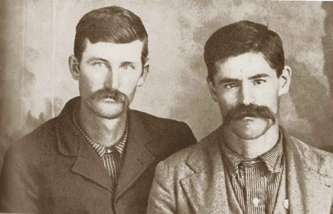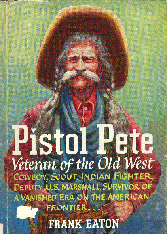Francis Boardman Eaton was born on October 26, 1860, in Hartford, Connecticut. In 1868, the Eaton family joined the rush to Kansas homesteading eight miles west of Carbondale, in Osage county. The Eatons built their home on the sight of an old hotel along the trail left by Quantrill’s raiders on their retreat to Lawrence. It was there the eight year old Frank saw his father gunned down in the moonlight by a lawless gang of Southerners who called themselves the Regulators. Mose Beaman, his father’s friend and neighbor, told young Frank, “My boy, may an old man’s curse rest upon you, if you do not try to avenge your father.”

Mose Beaman
Beaman gave Eaton his first gun, an old Navy revolver with an eight inch barrel and taught him to handle the gun. He learned to mold bullets and practiced his shot. Soon he was so proficient he could shoot the head off a rattlesnake with either hand by merely “point firing.” In 1876, Frank’s mother and two sisters moved to Indian Territory near the present site of Bartlesville. Later they moved to Cooweescoowee District which is now Deleware county. At the age of fifteen Frank went to Fort Gibson to see what the 6th Cavalry soldiers could teach him. He outshot everyone at the fort and Colonel Copinger, commander of the fort, gave him a badge for his marksmanship and said, “I am going to give you a new name. From now on you are Pistol Pete!” Jim Starr gave Eaton a Colt .45 and his first two boxes of factory made ammunition.
Eaton learned two of his fathers killers, Doc Ferber and Shannon Campsey, were living in a cabin on the Canadian River southwest of Webbers Falls. As Eaton rode into the clearing where the cabin was located Campsey grabbed his rifle. As Frank called out, “Hello, Shan, don’t you know me?” Campsey aimed and Eaton shot him dead on the porch. Eaton found Ferber working cattle in a nearby clearing and again proved his shooting ability, earning the second notch on his pistol. Ferber and Campsey were both known cattle thieves and for his action against them, Eaton was hired as a detective by the Cattlemen’s Association. Within three months he settled the blood debt with three more of his father’s killers.
Eaton had set off to find John Ferber who had been helping his brother and Campsey sell the stolen cattle in Missouri. The night before he arrived, Ferber was killed for stealing a jack from the bottom of a deck in a poker game. Eaton attended his funeral to make sure he was dead. However, he did learn that Jim and Jonce Campsey had a small ranch in the Ozarks. Eaton found the brothers at home and challenged them to a duel, killing both of them only feet apart. Now, only Wyley Campsey remained of his father’s killers.

Rolla Goodnight and Frank Eaton
In 1885, Eaton served as scout for Capt. Emmett Crawford in his fight against Geronimo and the Apache’s. It was during these battles that Eaton was nearly scalped. Afterwards, he returned to Indian Territory where he served as a deputy U. S. Marshal under Isaac Parker, the “Hanging Judge,” adding six more notches to his pistol in the line of duty.
In 1887, Eaton learned Wyley Campsey was tending bar in Albuquerque, New Mexico, so he headed west. With the help of Pat Garrett, Eaton located Campsey and entered the saloon. Campsey was at the bar with two of his hirelings. Eaton ordered Campsey to “fill your hand, you son of a bitch!” shooting him twice through the heart as he reached for his gun under the bar. However, the two guards wounded Eaton shooting him in the leg and in his left arm. Garrett helped Frank and saw to it he received help from friends out of town.
Eaton purchased a claim west of Perkins from Charlie Devore on October 6, 1889. He married Orpha Pearl Miller on August 20, 1890, and they had two daughters - Ethel Florence and Faye Etta. Orpha died on April 5, 1902, leaving Frank a widower with two small daughters.
Eaton married Anna Rosetta Sillix on January 1, 1903, and moved to 119 E Chantry in Perkins in the 1920’s. Together they had eight children - Orpha, Bessie, Mae, Elizabeth, William Rolla, Raymond, Eugene Francis, and Frank Jr. He had a blacksmith shop located at 203 S. Main Street. Boyd Sasser recalled as a child watching in fascination as Eaton would walk barefooted on the steaming hot boiler of a steam engine or pick up a red hot piece of metal in his shop with his toes. Elizabeth Eaton Wise explained her father had suffered frostbite and had no feeling in his feet allowing him to perform such feats. Eaton later moved the blacksmith shop to his home.
Eaton always wore his cowboy hat, vest, blue jeans or frontier pants. Many times he would be bare footed rather than in his boots. His large mustache and long braided hair were an ever present trademark. Asked about his long hair, Eaton replied, “If the girls are going to cut theirs off, I’ll let mine grow.” Youngsters loved to go to his house on Saturdays to listen to his yarns about the old days and to witness his lightening quick draw. Eaton always shot from the hip. In 1923, students at Oklahoma A & M College, now Oklahoma State University, asked Eaton to pose as the school’s mascot after seeing him in an Armistice Day parade. Eaton agreed and became the “original cowboy” and living symbol of Oklahoma State University until his death. His likeness was also adopted as the mascot of the University of Wyoming and New Mexico State University.


From 1950 to 1956 Eaton wrote a weekly column for The Perkins Journal titled “Truthful Pete Says” and later “Pistol Pete Says.” The stories consisted of his philosophy of life, humorous incidents, and recollections of frontier days. Eaton often told of his experiences as a member of The Journal staff setting type by hand and cranking the old hand press.


In 1952, with the help of Eva Gillhouse, Eaton wrote his autobiography, Pistol Pete, Veteran of the Old West, published by Little, Brown & Company. The Chicago Tribune called the book “an exciting genuine bit of Americana.” Eaton made several television appearances including the Danny Williams, Tom Paxton, and Prissy Thomas shows.
While talking to one of Dr. B. B. Chapman’s history classes at Oklahoma A & M in 1955, Eaton accidentally fired his gun in the Student Union Varsity Room while demonstrating his fast draw. Asked why he would carry a loaded gun, Frank replied, “By George. I’d rather have a pocketful of rocks than an unloaded gun.” Today a plaque marks the location where the bullet hit the wall in the Student Union basement.
One of Eaton’s last public appearances was in the fall of 1957, riding shotgun on an old Butterfield stagecoach during the half-time festivities at OSU homecoming. That winter he fell on an icy sidewalk breaking his pelvis. Eaton made a remarkable recovery in only a few weeks, able to resume his daily trips to the post office for the many letters he received from all over the world. He prided himself on never failing to answer a letter. Frank Eaton died in his sleep at home on Tuesday morning, April 8, 1958, at the age of 97.
Eaton’s funeral was held in the Perkins Community Building on Friday, April 11, at 2:00 p.m. Nearly 1,000 persons attended including Rolla Goodnight of Guthrie, Eaton’s closest friend; and Billy McGinty of Ripley, Teddy Roosevelt’s orderly in the rough riders. Eaton’s widow, Anna Rose, was bedfast and could not attend the rites. Rev. A. G. McCowan, a long time friend of Eaton’s officiated the services and said, “He had a tough exterior, but he was kind and tender hearted. Children loved him. He could quote Shakespeare, Plato, and Aristotle. He knew poetry.” Eaton himself had written, “I know St. Peter has me charged up pretty heavy, but unlike a mortal judge, He knows the innermost motive for every deed committed, whether good or evil, and I think He will not be too hard on a poor old cowboy who did his best as he saw it.” Eaton was buried in the Perkins Cemetery wearing a brown suit rather than his regular western attire, his Cherokee Strip cowpuncher ribbon and badge pinned to his chest, but without the six-shooter that had earned him his name. At the cemetery, Cecil Hiatt of Brahman strummed a guitar and sang a song about “Cowboy’s Heaven.”
After Eaton’s death, his revolver with 11 notches, holster, hat, boots, pocket watch, fiddle, and other effects were given to Jimmy Razook, a Wichita, Kansas, businessman by Eaton’s daughter, Mae, in return for a headstone for Eaton’s grave. In 1965, Razook’s nephew, Pat Razook, convinced his uncle to loan the items to OSU. The items were displayed in a glass case on the third floor of the Student Union, where they were soon stolen. The items were never recovered. Eaton’s 1892 Model Winchester rifle wound up in a Tulsa pawn shop in 1969. The rifle was purchased from a Michigan gun dealer by David Sasser in 1987 and is on display at the Eaton Home.
On March 15, 1997, the National Cowboy Hall of Fame honored Eaton posthumously by presenting him the prestigious Director’s Award. Eaton’s daughter, Elizabeth Wise, and Oklahoma State University president, Dr. James Halligan, accepted the award for Eaton.
In 1998, Campfire Stories: Remembrances of a Cowboy Legend was published by the Eaton family. The book was written by Eaton in 1957 and was serialized in The Perkins Journal by his daughter, Elizabeth.